We occasionally link to goods offered by vendors to help the reader find relevant products. Some of these may be affiliate based, meaning we earn small commissions (at no additional cost to you) if items are purchased. Here is more about what we do.
Have you ever wanted to slice and dice with a Chinese cleaver, but didn’t think you had the necessary skills to use it?
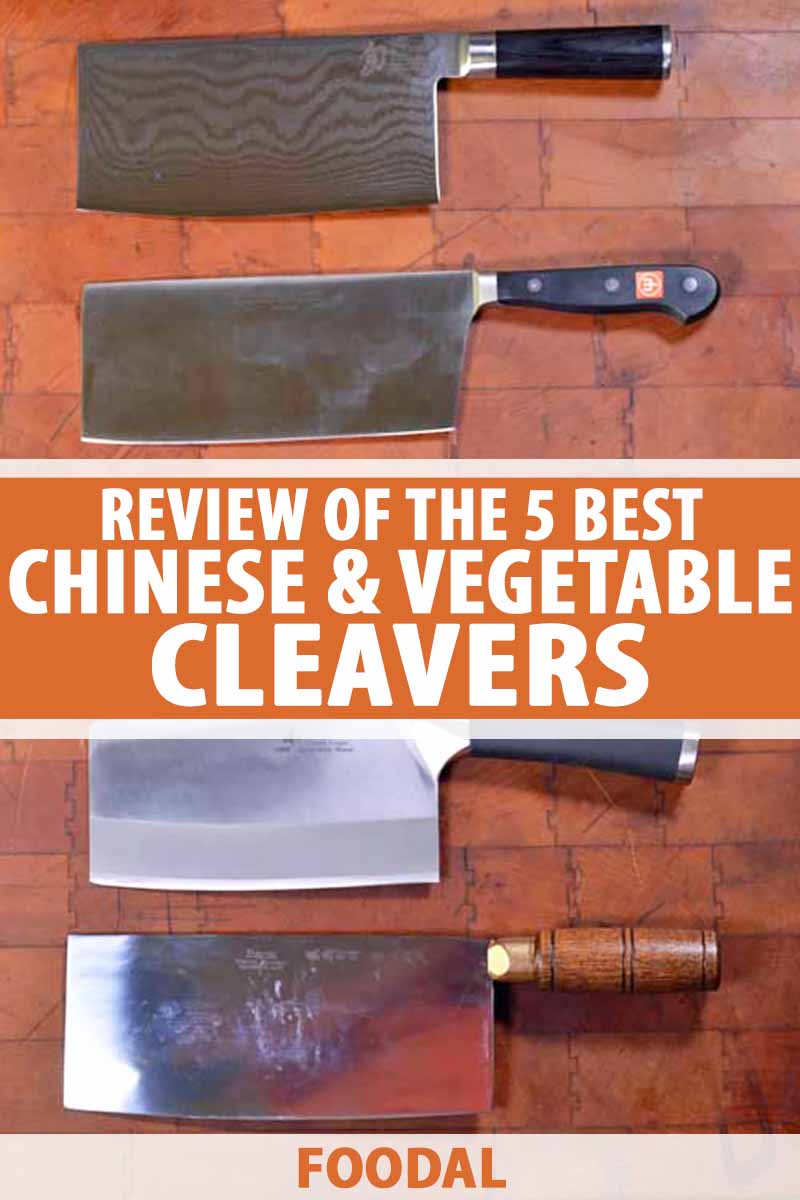
Well, the Chinese cleaver – which can also be referred to as a Chinese chef’s knife, Chinese vegetable cleaver, or vegetable cleaver – is a beautiful, multifaceted tool that deserves your attention.
And once you take the time to understand its design and uses, it’s easy to incorporate this knife into your daily kitchen prep.
These blades can accomplish nearly every function achieved by a regular chef’s knife, plus they have the ability to scoop up your chopped and sliced ingredients to safely transfer them to a container or pan.
Learn more about these beauties now!
The Best Chinese and Vegetable Cleavers
Our 5 Favorite Chinese and Vegetable Cleavers
A wonderful tool with a broad range of applications in food preparation, the Chinese cleaver is also great fun to use – you can clear a kitchen full of scamps in seconds with just a few overhead swings!
All joking aside, it really is handy to own one. We’ll take a closer look at this impressive tool in this guide.
Let’s begin with a quick roundup of the best Chinese cleavers currently available.
1. Shun Classic
After testing various models, we found the Shun Classic Chinese Vegetable Cleaver to be the best option, and this is our top recommended knife in this category.
From Shun, makers of fine Japanese kitchen knives, we have this strikingly handsome Chinese-style vegetable cleaver. From the company’s Classic line of kitchen knives, it features the elegant watermark design of Damascus cladding on both sides with the traditional tall, square profile.

Shun Classic, available on Amazon
This high-quality cutlery line is beloved by professional chefs and home cooks alike, and these tools are also NSF certified for use in commercial kitchens.
Shun’s manufacturing process produces a knife that’s equal parts beauty and function, delivering outstanding performance. The high-carbon, fully clad blade is tough and strong with a seriously sharp edge, and these components combine to form a truly elite cutting tool.
With its fine craftsmanship, sturdy weight, slim spine, and keen edge, the Shun Classic vegetable cleaver does most of the work – you just need to guide it along, for effortless cutting.
The blade itself measures 7 inches in length and 4 inches in width. Including the handle, it has an overall length of approximately 12 inches and weighs 13.6 ounces.
The beautiful blade is constructed with a core of proprietary high-carbon, high-performance VG-MAX super steel.
The core is protected with 34 layers of stainless steel Damascus cladding on each side, for a total of 68 layers, which is then ground and bead-blasted. This process reveals a flowing pattern of layered steel, reminiscent of moiré silk, with no two blades having identical patterns. Each one is unique in appearance.
The VG-MAX formula includes high levels of carbon to steel, to improve both strength and durability. It also contains chromium for wear and corrosion resistance, cobalt to enhance strength, and tungsten for a fine-grained steel that makes it possible to create a superbly fine and sharp edge.
There’s also molybdenum in the mix for corrosion resistance, and vanadium to counter brittleness with better impact resistance. The steel is hardened to achieve a rating of 60-61 on the Rockwell Hardness Scale.
The result is a blade that’s extremely sharp, durable, corrosion and stain resistant, and gorgeous to behold.
The cutting edge is honed to a double bevel of 16° – which is much sharper than Western blades that are typically ground to 20-22° – and has a slight symmetrical curve along its length.
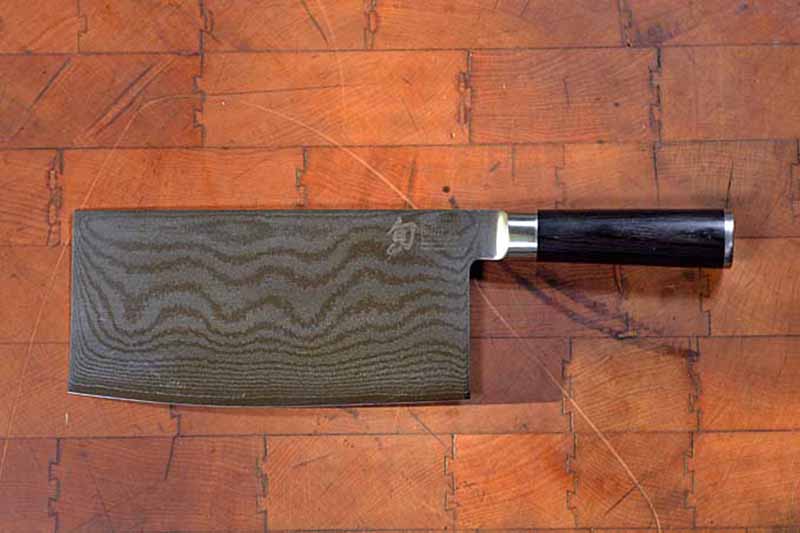
The Shun’s blade has an extremely flat belly across the majority of its length, allowing for stellar push-cut action, with a rounded, curved tip. This curved end allows for delicate rock-chopping of finer herbs and leafy greens. All in all, it’s the perfect geometry for this type of knife.
Most of the blade is able to lay flat on your cutting board at any given time. This is the proper blade profile for a useful Chinese vegetable cleaver.
The D-shaped handle is constructed of ebony-finished Pakkawood, a resin-impregnated hardwood that’s moisture resistant, strong, and hard wearing.
Though the handle is designed to tuck into the palm of a right-handed user, minimizing the gap between handle and hand, the company states that this shape still offers control and stability for left-handed users as well. For lefties, the ridge provides a spot to rest the fingertips in a pinch grip, and this configuration provides the same benefits in terms of stability and control.
However, the company suggests that the best way to check the comfort level is to hold it in person before you make your purchase. Return policies at various online vendors may allow for home testing as well.
The handle is fitted with a full tang and stainless steel bolster, which gives even greater control along with superb balance. And a stainless steel end cap on the heel finishes it all off.
Shun recommends hand washing and prompt drying to keep the blade sharp and in pristine condition.
Weekly honing with a ceramic or non-ribbed steel, or a leather strop, will help to maintain a sharp edge. Sharpen as needed with whetstones or an electric sharpener that creates the correct 16° angle.
Or, better yet, send it to the manufacturer!
Along with Shun’s limited lifetime warranty, your purchase also includes lifetime access to Shun’s free knife sharpening program, as long as you buy the knife via an authorized dealer.
You will have to pay fees for shipping and processing, and the total estimated length of time for sharpening service and returning the knife to your home is about 3 weeks.
Suitable for cutting vegetables and fruit, this knife is not meant to be used on bones of any size, lobster shells, or for cutting through joints. If you do so, you run the very probable risk of chipping the sharp, hard cutting edge.
Though the price of this blade this won’t fit everyone’s budget, it’s an elegant and beautifully crafted vegetable knife that delivers top-notch performance and aesthetics.
You can review prices and customer comments on Amazon now.
2. Wusthof Classic
Another top option is the Wusthof Classic Chinese Chef’s Knife. We found its proportions were similar to those of the Shun, in that it has a very flat cutting edge just past the curved tip all the way to the heel.
Wusthof is known for their very high-quality line of fully forged kitchen knives, a favorite with chefs and home cooks who want the best of the best. The Classic line is made in one of the world’s premier knife-making cities in Solingen, Germany.
“Made In Solingen” is a registered trademark given to all knives in Wusthof’s Classic line, meaning that all key manufacturing stages must have been processed and finished in Solingen, and it must meet strict standards of quality.
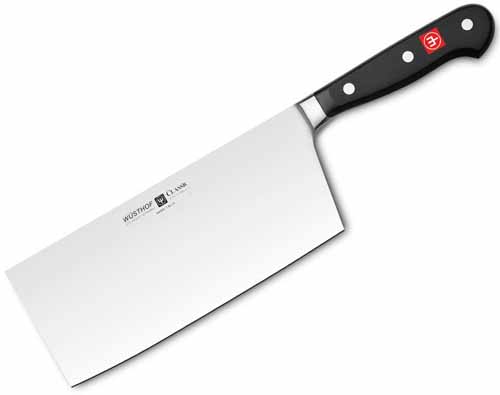
Wusthof Classic, available on Amazon
The cutting tools in Wusthof’s Classic line will stand up to greater abuse than Shun’s VG-Max steel as well, making it ideal for those who have household members who unintentionally fail to treat household implements with care before and after each use.
The tradeoff is that the Wusthof will never be as sharp as the Shun, or hold its edge for the same length of time. That being said, it’s a quality blade that performs incredibly well in the kitchen.
The fully forged X50CrMoV15 stainless alloy blade is constructed of a high-carbon molybdenum/vanadium material, and hardened to 58 HRC for a long-lasting and durable edge.
The one-piece, fully forged construction provides a full tang, which is triple riveted to the polypropylene handle for precise and balanced weight distribution, stability, and durability.
This alloy and corresponding hardening provides a good mix of edge retention and durability. This blade may be sharpened more easily and it is less likely to chip than its typical Japanese counterparts.
The blade is 7 inches in length and 3.05 inches in width. The handle is 4.4 inches long. The total weight is 14.4 ounces.
Designed in the style of a Chinese chef’s knife, the Wusthof Classic’s broad blade with double-beveled edge is ideal for prepping vegetables, meat, and fish. And it’s suitable for all cutting duties – slicing, chopping, mincing, scooping, and more.
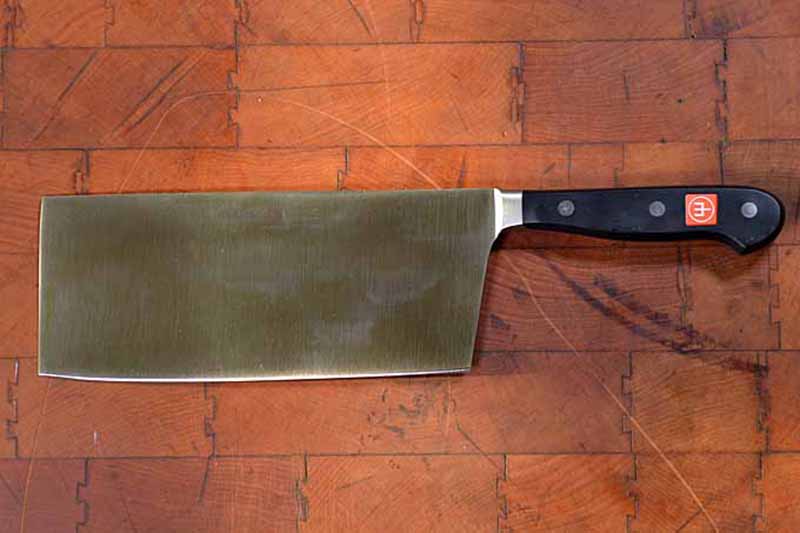
We like the flat profile of the blade, which can easily push-cut harder vegetables with no “clingers” – those annoying little pieces that can stick to the blade. And the round tip allows for rock chopping of finer herbs and leafy greens.
This model is ideal for the home cook or professional chef who doesn’t want to invest in a set of water stones, which are a necessary accessory for sharpening Japanese steel.
Wusthof blades are sharpened to 14° on each side. This cleaver can be sharpened on anything including wet/oil stones, diamond pads, and ceramic rods. Or it can be taken your local neighborhood sharpening service with no worries.
Please note that this is a vegetable knife – with this type of blade material, do not use it on bones or any tough materials. Hand wash in warm, soapy water, rinse, and dry promptly.
The Wusthof’s handle is designed as ambidextrous, unlike the Shun. It can be used by right and left handers equally well.
This blade comes with Wusthof’s lifetime manufacturing warranty.
Check out prices and customer comments on Amazon now.
3. Zhen 3-Layer Forged Light
Zhen has been producing knives in Taiwan since the early 1990s, and uses only imported Japanese VG-10 steel for all of their blades – which creates extremely sharp knives designed for fine, detailed cutting.
Super sharp with a long-lasting edge, the Zhen is light, agile, and highly functional for all slicing and chopping duties. And with the high quality of the construction and steel used, it would be hard to find equal value for a lower price.

ZHEN Japanese 3-Layer Forged Light, available on Amazon
This Chinese cleaver is from Zhen’s 3-Layer Forged series, with a selection of knives forged with three layers of steel.
The blade is 6.5 inches in length and 3 inches in width, and has an overall length of 11.5 inches. It weighs .58 pounds.
The Damascus VG-10 core produces an outstandingly sharp, tough, and long-lasting edge while the clad layers of high carbon stainless on each side provide corrosion and stain resistance.
VG-10 is a staple formula used in many top-of-the-line Japanese blades. This cutlery grade stainless steel material is comprised of 1% carbon, 15% chromium, 1% molybdenum, 1.5% cobalt, and .2% vanadium. It is then heat-treated and hardened to 60-62 HRC on the Rockwell Scale for Zhen’s knife blades.
Lightweight with a broad blade that makes chopping, slicing, and scooping easy and efficient, the blade has a frosted finish for better food-release qualities. With the slightly curved belly, it’s ideal for slicing, chopping, and rocking strokes.
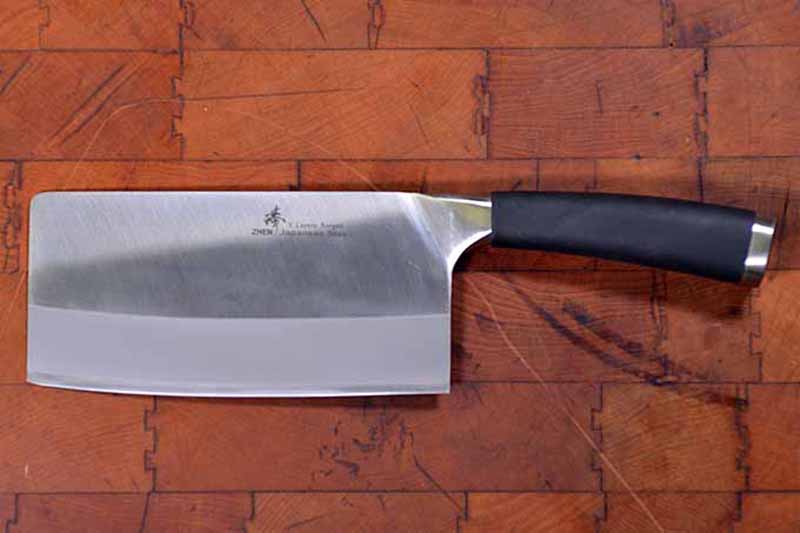
With a full tang, the lightweight design is perfectly balanced for reduced hand and forearm fatigue, and it provides great edge control. The stainless bolster is seamlessly integrated with the blade body, and a stainless steel end cap completes the knife.
The ergonomic oval handle is constructed of durable TPR rubber that’s molded to the tang for a comfortable, waterproof, slip-free, and antibacterial surface that provides a strong, secure grip.
Both the double-beveled blade as well as the handle design easily accommodates both left-handed and right-handed users.
As we will never fail to repeat, please remember that this is a vegetable cleaver, and is not intended to chop bones, joints, or tough connective tissue – doing so may cause the hard core of the blade to chip.
Hand wash your cleaver with mild dish soap, rinse, and towel dry immediately. Hone your edges weekly with a steel or ceramic rod to keep it sharp. Zhen also recommends sharpening with a whetstone at an angle of 15°.
Made in Taiwan, Zhen offers a 100% satisfaction guarantee.
While it may lack the cachet and fame of better-known brands, it’s an excellent bargain for those who like hard, sharp Japanese steel.
Check prices and read customer review on Amazon now.
4. Zwilling J.A. Henckels Twin Signature
From their Twin Signature line, Zwilling J.A. Henckels brings us their sleek and efficient 7-inch vegetable cleaver.
A versatile performer in the kitchen, all aspects of the high-quality construction of this model shine.
Weighing .66 pounds, the Twin Signature delivers big results in a lightweight package. With a stamped blade made of Zwilling’s proprietary steel, it proves to be lively and responsive to all chopping duties.

Zwilling J.A. Henckels Twin Signature, available on Amazon
The Zwilling J.A. Henckels Twin Signature vegetable cleaver comes in as a bit of a dark horse. From one of their more economical lines, it offers all of the performance, durability, and versatility likely to be found in more expensive models.
Very lightweight, comfortable, and nicely balanced, it makes handling numerous cutting tasks a pleasure. The Twin Signature offers excellent value for a thoughtfully designed and well-constructed vegetable cleaver.
The Twin Signature is the only stamped line of knives produced by Zwilling, designed to offer outstanding sharpness and performance for a reasonable price – ideal for those starting out in their first kitchen, or for folks who just like a good bargain.
Stamped with precision from a single piece of Zwilling’s special formula steel, the blade is ice-hardened using Zwilling’s proprietary Friodur process for a blade that guarantees an optimal blend of hardness and toughness, as well as stain and corrosion resistance.
The special formula steel is composed of optimal quantities of iron, carbon, and chromium for excellent hardness, as well as corrosion resistance.
And, after going through the four steps of the Zwilling trademarked Friodur ice-hardening process of heating, cooling, deep-freezing, and tempering, the blades emerge with a hardness of approximately 55-58 HRC on the Rockwell Scale – with durability and flexibility being key characteristics.
Each blade is professionally hand sharpened and polished to 15° on each side in the laser-controlled sharpening process, which produces a symmetrical, V-shaped edge. This guarantees excellent initial sharpness, long-lasting cutting performance, and edge stability.

The curved edge along the belly may hinder the push-cutting action, making this style of blade more akin to a traditional European chef’s knife than a Chinese cleaver.
But that’s not to say it is inferior with the majority of prepping responsibilities!
With the traditional large, squared-off profile and slight convex curve to the blade belly, it’s the perfect knife for cutting and preparation of all vegetables, as well as the delicate, paper-thin slicing of meat, poultry, and fish.
But please be aware that this is not a meat cleaver – it’s for cutting vegetables and should never be used to cut through bones, as the hard steel may chip or break.
The ergonomically designed polymer handle has a bolsterless hilt, and is securely attached to the full and exposed tang with a traditional design of three stainless-steel rivets. Tough, resilient, and stain resistant, it also proudly displays the brand’s logo.
Plus, with the curved hilt, it’s easy to use the professional pinch grip comfortably for safe, secure handling.
Although it is dishwasher safe, hand washing and prompt drying is recommended to retain its sharp edge and looks.
The Twin Signature cleaver has a blade length of 7.09 inches and a blade width of 3.15 inches. Combined with the 5.31-inch handle, the overall length of the entire cleaver is 12.4 inches.
Made in Germany, it comes with Zwilling’s lifetime warranty to be free of manufacturer’s defects.
Check prices and read customer reviews on Amazon now, or purchase it directly from Zwilling.
5. Dexter-Russell Traditional
From American knife makers Dexter-Russell, we have the classic styling of this Chinese chef’s knife from their aptly named Traditional line of cutlery, featuring a polished rosewood handle and large brass compression rivet.
The Traditional line uses a proprietary blend of high-carbon alloys with stainless steel for consistent, reliable performance.
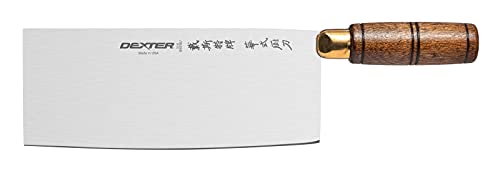
Dexter-Russell Traditional, available on Amazon
The high-carbon stainless is blended to combine the best attributes of both carbon steel and cutlery grade stainless steel. It won’t discolor or stain, maintains a sharp edge for long periods, and is easier to sharpen than stainless.
The high-quality alloys used for the Traditional line include molybdenum, vanadium, and cobalt to improve strength, edge-holding, and cutting performance.
Each knife blank is heat treated to a hardness of 54-56 HRC, and edges are individually hand ground and honed to a double-bevel profile for flexibility and durability. The double bevel makes it equally appropriate for right or left-handed cutting.
The unique edge geometry, at 20° for the first two thirds of the blade and about 25° for the last third to the heel, is ideal for the cutting tasks expected of a chef’s knife. It also ensures a long-lasting blade edge that’s easily restored to top performance each time it’s sharpened.
Large in area, this blade is fairly thin, but with a softer steel that isn’t as prone to chipping as those with higher HRC ratings. Make no mistake – this is a vegetable knife and it should not be used on bones or other dense, hard materials.
However, it may survive a fall onto tile without chipping, unlike some of its harder counterparts.
The blade profile is completely curved, which is a great design for rock-chopping herbs and small greens, but will make the push-cutting action more of a chore.
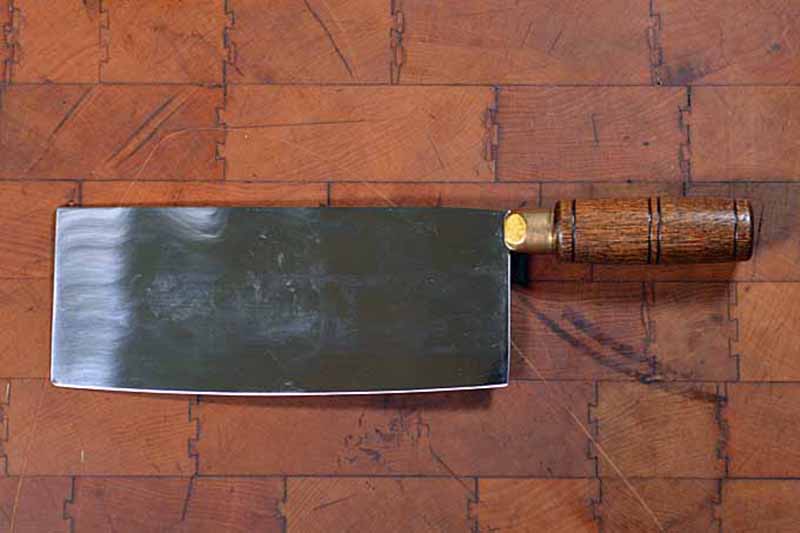
The durable natural rosewood handle is securely attached to the half-tang with brass compression rivets, and the carved, oval shape provides a comfortable, secure grip for all chopping duties.
The Traditional Chinese cleaver should be hand washed in warm, soapy water, rinsed, then dried with a towel promptly.
It has a blade that measures approximately 8-by-3.25 inches, with an overall length of 11 inches including the handle, and it weighs 12 ounces.
Made in the United States, it comes with Dexter-Russell’s limited lifetime warranty to be free of manufacturing defects.
As a warning: your knife may arrive with an informational sticker adhering directly to the blade, like ours. Extra effort is required to safely remove the residue without scratching the blade!
Check prices and reviews on Amazon now.
Meat Cleavers Vs. Chinese Cleavers
The Chinese chef’s knife, sometimes referred to as a chukabocko in Japanese versions, is much more delicate than a meat cleaver and can be utilized for finesse work – as well as many other applications aside from cutting.
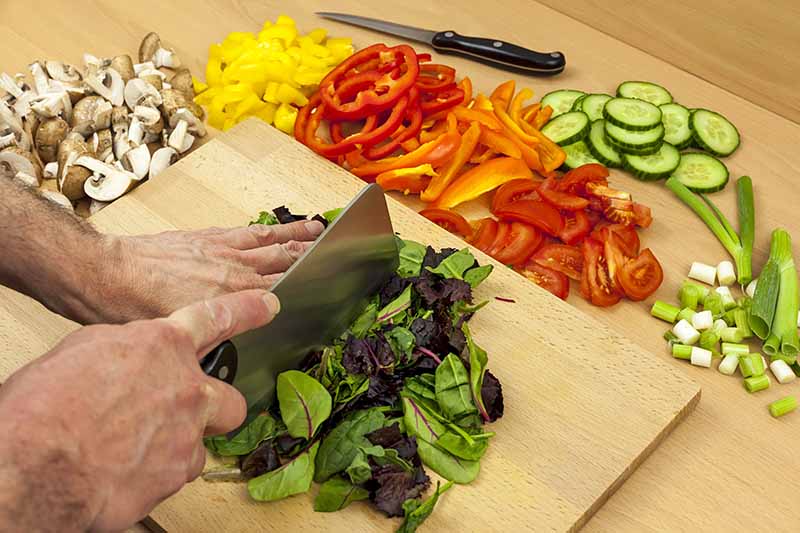
The chukabocko style is basically the same as a Chinese chef’s knife, but the production techniques used are usually more refined. It’s constructed of Japanese steel alloys, and it’s typically more expensive.
A large, square-tipped Chinese chef’s knife is a reliable tool for all kitchen tasks, and a go-to blade for many professional chefs and home cooks.
Lightweight and versatile, the Chinese chef’s knife is an all-purpose tool that will pound, chop, crush, mince, scoop, and slice food – even the heel of the handle is used for bashing and grinding.
With a narrow cross-section, it’s flexible and able to handle delicate peeling, chopping, and slicing duties – which are beyond the realm of a butcher’s cleaver’s abilities.
It’s primarily a vegetable knife used for chopping, but it also doubles as a slicing knife for shaving fine slivers from meat and other proteins – and it’s definitely not meant for hacking through large bones. You’ll need a much heavier cleaver with a thick cross-section for that purpose, or a butcher’s saw.
On the other hand, a meat or butcher’s cleaver is designed to be swung like a hammer. It’s big and heavy, with a thick, dense blade that won’t chip, crack, or buckle when chopping through hard bone. The cutting edge will also be more blunt, often with a 25° angle compared to 20-22° for Western knives, or 15-18° for Eastern blades.
In comparison, the Chinese chef’s knife has a slender, fine nature with a thin blade designed for slicing and chopping. And while the size and shape are similar, the blade steel is usually much higher in carbon, which makes it hard and somewhat brittle, and prone to chipping if it’s ever used on hard bone.
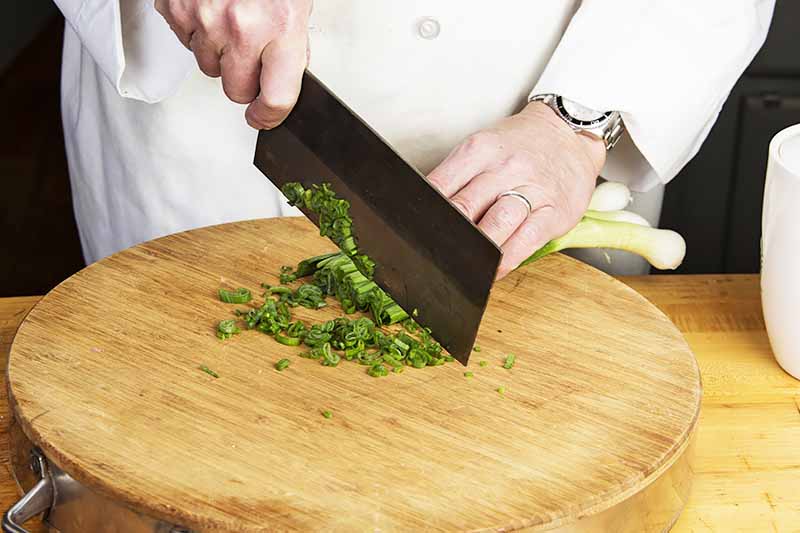
Much thinner in cross-section than a butcher’s cleaver, Chinese models are intended for more general work in the kitchen, similar to that of a Western chef’s knife or the Japanese santoku.
It has enough height that you can use it to scoop up large amounts of product like a spatula or bench scraper, and enough mass that the spine can be used to pound and tenderize meat. And the flat of the blade has enough surface area to flatten and crush ingredients like garlic, ginger, or nuts.
Another difference worth noting between this and a meat cleaver is that the blade is somewhat heavier toward the tip. This is to encourage the tapping and pushing strokes used by experienced Chinese chefs.
The edge is honed to a tight 15° angle, though a thickness up to 20° is not uncommon. The blade is mostly straight, which makes it excellent for chopping, but it should have just enough of a belly curve to be useful for pushing or rocking strokes as well.
The handle is also lighter than that of a cleaver, suitable for delicate slicing techniques, as opposed to the heft needed to cleave through bone and tough connective tissue.
A traditional handle will be round or oval shaped and made of wood, although modern versions may come in a variety of materials including metal, and may be riveted in place or held with injection-molded plastics. Finger grips are also found on many contemporary styles, and a full tang is the usual construction style.
Explore Styles
A closer look reveals that not all Chinese cleavers are created equal, or designed for the same purposes.
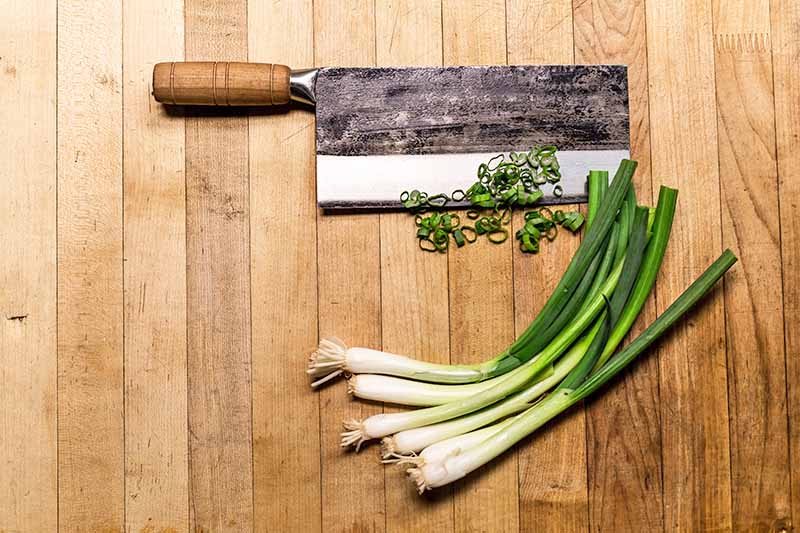
In today’s market, contemporary models come in three different versions: slicers, choppers, and cleavers. The most notable distinction between these is the thickness of the blades.
Slicers
Also known as ping knives, these are often referred to as vegetable knives as well. Of the three styles, they have the thinnest blades in the cross-section, and with a tight bevel, are also the sharpest.
They often won’t be as tall or as long as choppers or cleavers, and have an appearance very similar to that of a Japanese nakiri knife.
Slicers are used for cutting up vegetables, mincing herbs, peeling, paring, and slicing very thin strips of meat for stir-frying in a wok. But because of the thinness of the blade, it should never be used on bone.
Choppers
These are the type most often associated with the Chinese chef’s knife moniker, and have a slightly thicker blade than slicers.
But they’re not as thick as cleavers, and may be used for most general duties.
A chopper can be used on meats, vegetables, and herbs, and performs all slicing, chopping, and mincing duties wonderfully. And due to its height, it’s also very convenient to use as a scoop to transfer ingredients from the cutting board to the wok or another dish.
Also, because of the large face paired with its lightweight and nimble nature, this is the perfect knife to utilize if you’ll be prepping mounds of veggies – like the amounts typical at canning and freezing times.
Don’t want your knife to tire you out?
This is the one to choose.
Depending on the type of steel used, and according to manufacturer’s recommendations, some may also be suitable for chopping through soft or thin bones in poultry and seafood. But this is not recommended for most, so please always check the instructions before using on any hard tissue.
Cleavers
Also known as bone choppers, these have thick and heavy blades similar to their Western counterparts, meat or butcher’s cleavers. They’re suitable for chopping bones such as pork ribs, beef, and poultry, and for cutting through the tough, dense connective tissue of joints.
They have a wide bevel and the dullest edge of the lot, as heft and momentum provide most of the cutting action.
Features to Look For
Historically fabricated of carbon steel, today you’ll find many blades made of high tech, super-strong alloys. The material used will often have a high-carbon content combined with stainless steel materials to provide strength and durability, as well as stain, rust, and corrosion resistance.

And like all fine knives, a good Chinese cleaver will be well balanced and professionally constructed, with a fine edge that holds its sharpness well.
Blade, Length, Weight, and Construction
Blade length can measure anywhere from seven to eleven inches, with a height of three to five inches. Size selection is really a matter of personal preference.
Due to the large area of the blade, which requires a lot of metal to create, weight can sometimes be an issue. So look for ones that are lightweight with a good balance if you intend to do a lot of prep work, or have strength issues in your hands, wrists, or forearms.
Look for a tang that extends at least three-quarters into the handle, with a full tang offering the greatest strength, balance, and edge stability.
Handles can be of a traditional design and materials, cylindrical in shape and made of wood. Or they might be equipped with a modern handle of molded polypropylene, or hollow stainless steel.
Japanese vs. European Steels: How the Rockwell Scale Affects Performance
Most European brands will be hardened to 57-58 on the Rockwell Hardness Scale (RHS) whereas the Japanese types will typically be hardened to 60-62 RHS.
Though this may not seem like much, it’s a huge jump.
Here’s the thing:
The Rockwell Hardness Scale is not linear. It’s computed according to how far a diamond point under pressure will penetrate, and increasing by 4 or 5 points means the Japanese steel is much, much harder.
This increase in hardness allows the knife to become much more sharp, and even more importantly, allows it to retain this edge much longer.
However, this is not without its tradeoffs.
The harder the steel is, the more brittle it becomes. And most Japanese blades can’t take abuse by being pounded into bone or dropped on ceramic tiles. They will chip.
Japanese blades also need water stones to be resharpened, whereas European models can be sharpened using nearly every variety of sharpening system.
Angle of the Edge
Japanese blades are generally sharpened at 11-20°, which creates an extremely sharp edge. Due to the hardness of the steel, the metal can retain such a sharp angle without dulling for a very long time.
Most European knife makers sharpen their models to 20-30°. This assists with offsetting the effects of their softer steel and keeps it sharp a bit longer. However, the more obtuse angle means the edge will never become as sharp as one with a more acute grind.
Types of Steel
European makers stick with tried and true alloys of high carbon stainless steel, whereas Japanese manufacturers often use exotic combinations, some of which are not allowed to leave Japan in an unfinished form.
The steels have varying properties and can assist with edge retention, as well as metallurgical properties that assist with sharpening on the sharpening stones.
The Final Cut
You’ll be pleased with any of our recommended options as you’re speeding through prep work for an entire week’s worth of meals, or showing off your knife skills to a select few guests during a relaxed dinner party.

The major takeaway here is to understand the intended responsibilities that this type of knife is designed for, as well as its obvious limitations.
While it may look like a hearty and heavy meat cleaver that can hack through bone with ease, Chinese cleavers are most certainly not intended for that kind of use in the kitchen.
Avoid any serious damage to the blade by treating your cleaver with the respect it deserves!
What do you think, readers: do you have any encouraging experiences with a Chinese cleaver to share, or maybe a question we haven’t covered?
If so, let us know in the comments below. We always appreciate your thoughts!
Looking for other tools to upgrade in your kitchen? We have more reviews to share with you now:
Photos by Mike Quinn, © Ask the Experts, LLC. ALL RIGHTS RESERVED. See our TOS for more details. Originally published on October 30, 2016. Last updated on February 4, 2022. With additional writing and editing by Nikki Cervone. Product photos via Amazon.
About Lorna Kring
Recently retired as a costume specialist in the TV and film industry, Lorna now enjoys blogging on contemporary lifestyle themes. A bit daft about the garden, she’s particularly obsessed with organic tomatoes and herbs, and delights in breaking bread with family and friends.


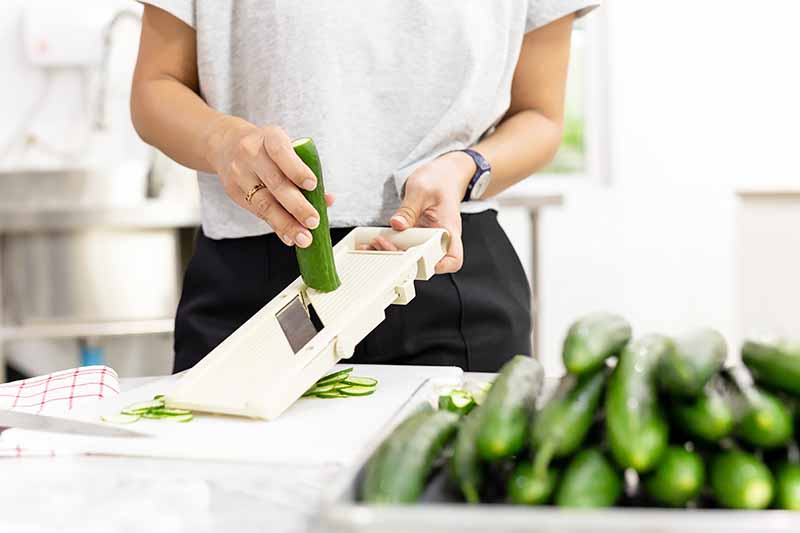
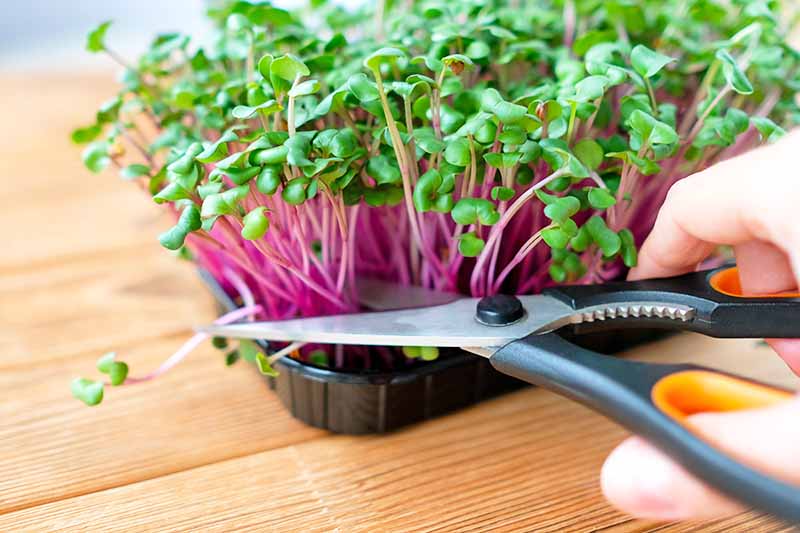

Thanks! Ordering the Shun now.
One thing, your cutting board in the pics, looks like my board that I made from a die cutters base.
Can you tell me about it??
Thanks,
John
Sorry for the late reply John.
It’s the top of a free standing 8 inch Boos butcher block made of end grain maple. It’s darker than one would associate maple with due to age (oxidation) and copious amounts of beeswax and mineral oil.
I’m now liking Japanse eucalyptus boards. Light and knife edge friendly…and can easily move product or be taken to the sink for a quick washing.
Natural rubber boards are decent too but not quite as edge friendly and a bit heavier…but likely more durable.
Another German company, Messermeister, makes a superb cleaver that rivals the Wusthof in every way. They were the company that also produced cleavers for Martin Yan, the Master of the Cleaver. Harder to find than the Wusthof or Henckels but worth the hunt.
Hello Hippo,
Yes, we recommend Messermeister as our top rated western style chef’s knife, but it’s apples to oranges to a Japanese style veggie cleaver which is designed to be very sharp and very thin to chop veggies. Western style blades can’t retain sharpness like harder (but brittle) Japanese style steel.
Japanese knives absolutely do NOT need water stones to be resharpened! This is a lot of old tosh.
I have been making, selling and restoring swords and knives for over 20 years.
And yes, when younger I too bought into this nonsense about only using the best (expensive) natural Japanese water stones for sharpening and polishing blades. But it simply is not necessary. I can achieve the same finish using wet and dry sand paper on a piece of glass (I use a very true piece of granite, simply because it’s heavy and I have it).
It is very much cheaper than buying a full set of fragile stones, for exactly the same results.
Try it and see.
So Peter,
You must have looked really, really hard to find that one sentence that you disagreed with. Nowhere did we mention NATURAL water stones.
I’ve tried “scary sharp” and wouldn’t recommend it. If you don’t have a completely flat surface to work off you’re going to be picking glass out of your teeth. Yes, granite would be better but it’s still a pain in the rear to to scrape up old sandpaper, clean the surface, apply spray adhesive, and stick the paper down.
Personally, I’d rather shell out $80 and get a couple of SYNTHETIC water stones.
Save those natural stones for the straight razor boys.
Honestly I have all of these and more. On this list my favorite is probably the dexter but it is a bit too rocky as you mentioned.
To tell you the truth, I would only recommend two cleavers. If you want a cheap one go with the tried and true winco. If you want a good one go with chefknivestogo CCK Small Cleaver (which is not on your list). The winco is a nearly perfect cheapo you don’t mind beating up and practicing sharpening on. The CCK small cleaver can get much sharper than the winco and holds and edge better due to being just better metal/heat treating and it looks better and has better construction. or get both, one to beat up and one to take care of. Just a note though the cck cleaver is not stainless so it’s definitely a different beast if you’ve never owned a carbon steel knife. Still it just flat out performs better than any cleaver I’ve had. I can get it so dang sharp too. Just cut a hair into 4 if I wanted to.
The rest of these all went back on ebay for me except for the dexter which I kind of reprofiled to my liking. The dexter is now my beater with the modifications and my winco is in my camping bag (super beater). But still I would recommend either buying the winco or cck for most people, don’t need an in betweener role if you don’t already own it.
forgot to mention cck does also make a stainless cleaver but i dont like it as much. wokshop also makes a no name (not stainless) cleaver that is a nice learning cleaver you can abuse and learn to sharpen on. It gets dang sharp too for like 10 bucks
I realize that I am late to the party, but if there is a “Chinatown” near you, you can buy a cleaver better than anything described in this article for about $20.
Hi, You have shared good knowledge about these cleaver knives. thank you
A Beautiful knife for my kitchen multitasks. Very happy with the design and quality. Superb customer service. I would recommend to anyone needing something beautiful to work with, to try Almazan Knives products.